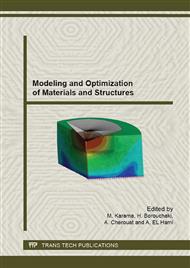p.25
p.32
p.37
p.41
p.44
p.52
p.61
p.71
p.80
Numerical Modeling of the Flow of Particle-Filled Resin through a Dual Scale Fibrous Media
Abstract:
We present numerical simulation of particle filled resin flow through a fibrous media taking into account dual scale porosity in LCM (Liquid Composite Molding) processes. During the flow, a strong interaction between the particle motion and the fluid flow takes place at the porous medium wall or at the fiber bundle surface. A model is developed to describe the particle retention and filtration in the porous media. In this study, the Stokes-Darcy equation is solved to describe the resin flow in a mesoscopic scale. The particle retention mechanism is extensively studied taking into account the influences from such parameters as size and concentration of particles. The particle filled resin flow through a fibrous media simulation is performed to demonstrate the effect on the retention and filtration mechanism during the composites manufacturing by LCM processes.
Info:
Periodical:
Pages:
44-51
Citation:
Online since:
April 2015
Authors:
Keywords:
Price:
Сopyright:
© 2015 Trans Tech Publications Ltd. All Rights Reserved
Share:
Citation:


